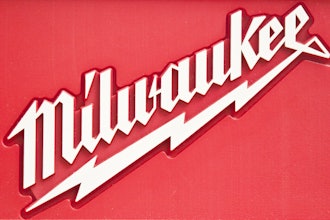As a leading manufacturer of large jet aircraft engines, General Electric is responsible not only for building new, top-of-the-line engines for aerospace, but also, through its Engine Services division, for keeping them functioning properly. The GE Engine Services team in Strother, KS repairs, overhauls, and performs general maintenance on new and used aircraft engine components.
For the past 12 years, GE Strother used a waterjet stripping machine with a closed-loop filtering process to remove thermal sprayed coatings from jet engine components. Thermal coatings, made of ultra-fine-grained metal alloys or ceramics, are applied to protect the base material of components that are exposed to heavy contact with other rotating parts. When refurbishing a thermal-coated part, the team at GE Strother must first strip the original coating and then reapply it to its original thickness.
Originally, a 4-axis gantry device with a CNC controller and ultra-high-pressure intensifier was used for stripping parts. This closed-loop process contained multiple high cost filtration devices for cleaning and recycling the water used within the cell. Poor water quality can lead to extensive wear on the intensifier’s seals and the waterjet nozzles, which in turn drove up maintenance and operational costs and reduced system availability. These constraints, coupled with the limitations of using a 4-axis system rather than a more flexible 6- to 8-axis system, led the company to research its options when considering a replacement system.
Flexible, Cost-Effective Solution
GE turned to KMT Robotics Solutions, a global leader in flexible robotic systems, to design and implement a more flexible, efficient, and cost-effective solution. The company’s solution was an open-loop customized stripping system utilizing a 6-axis robot, rotating table, and intuitive programming software.
“KMT worked hand-in-hand with GE Engineering to develop an efficient, open-loop filtering solution for stripping the process waste,” said GE Engine Services special process engineer John Segovia. “This included great outside-the-box thinking and simple ideas for a complex problem.”
KMT supplied GE with a customized Stationary IV Stripping system. The solution includes a robot with a KMT Rotojet cleaning head, CleaningWare software, and a KMT Streamline SL-V 100R Plus intensifier. The system features an overhead inverted rail-mounted, 6-axis ABB IRB 2400 robot from ABB Robotics. The inverted robot model’s compact design, robust construction, and configuration for use in wet environments contribute to its high reliability and long intervals between maintenance. The 6-axis robot mounted on the 7th axis rail with the additional 8th axis rotating table gives the system much more flexibility and dexterity than the previous 4-axis gantry system.
“The additional robot axis was very beneficial to our stripping process,” Segovia said. “We constantly acquire new and different parts to repair. Now we’re only limited by the size of the cell, and not by the type of part that needs to be stripped.”
Enhanced Human-to-Machine Communication
Mounted next to the Rotojet cleaning head is a search probe that ensures the part is in the cleaning area, and an air nozzle to remove water from the part after it is stripped. The easy-to-use CleaningWare software from KMT Robotic Solutions follows the ABB program standard and offers fast editing of operating programs with a number of software options such as 2D shape path generation. The software enhances human-to-machine communication and allows the operator to adjust the water pressure to minimize wear on the flexible high-pressure tubes and hoses.
Operators load parts into the system with the help of a Telfer crane, or by hand. Once the part is loaded onto the rotating table, the operator scans a bar code that automatically calls up the correct stripping program. The water used to strip the part is pumped through the cleaning nozzle at very high pressure via a Streamline SL-V 100R Plus intensifier. The intensifier is supplied by KMT Waterjet, KMT Robotic Solutions’ sister company in Baxter Springs, KS.
According to Segovia, with the use of fresh water from the plant’s water supply the intensifier works much more reliably and the company has reduced filter costs by 75%. Productivity, cycle time, and flexibility have also been improved with the implementation of the 8-axis system, enabling GE Strother to process 25% more parts than its previous capacity. The company has also realized additional savings in training costs and uptime due to the easy-to-program and operate CleaningWare software. With these cost savings and improvements to the company’s production and efficiency the new system easily justifies its purchase and implementation.



















